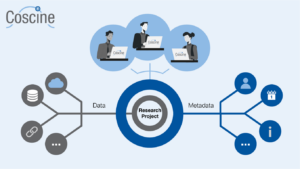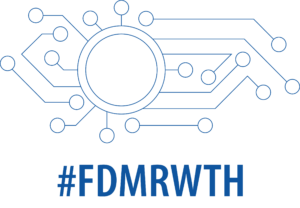Vor Kurzem berichtete das IT Center Blog-Team über das groß angelegte Projekt „Die Archivmigration“ – Was bisher geschah“ des IT Centers und der RWTH Aachen University. Bis zum 30. Juni 2022 soll die Archivmigration abgeschlossen sein und alle klassifizierten Archivknoten in Coscine und das DigitalArchiv überführt werden. Die Archivierung von Forschungsdaten ist bereits seit letztem Jahr mit Coscine möglich. In diesem Beitrag gehen wir auf einige Rückfragen von Forschenden ein und erläutern die Hintergründe, warum Sie Ihre Forschungsdaten mit Coscine archivieren sollten.
Coscine (Collaborative Scientific Integration Environment)
Mit Coscine speichern, verwalten und archivieren Sie Ihre Forschungsdaten im Sinne der guten wissenschaftlichen Praxis effizient und langfristig. RWTH-Mitgliedern steht zudem ein Zugang zum kostenlosen Speicherplatz zu. Zugleich haben alle Projektmitglieder eines Projekts Zugriff auf die Forschungsdaten. Anhand von Applikationsprofilen werden die Forschungsdaten mit Metadaten verknüpft. So werden die Forschungsdaten in ihrem Projektkontext dokumentiert.
Was sind zu archvierende Forschungsdaten?
Unter Forschungsdaten werden Ergebnisse aus der wissenschaftlichen Forschung wie beispielsweise Laborwerte, Messdaten, Survey- oder Beobachtungsdaten, Korpora, Simulationen und vielen weiteren Daten verstanden. Zu den zu archivierenden Forschungsdaten gehören alle Daten, die für den Projektkontext dauerhaft benötigt werden, um beispielsweise gemäß der guten wissenschaftlichen Praxis zu handeln. Dabei ist es wichtig, einen strukturierten Umgang mit den eigenen Forschungsdaten zu pflegen. Wie Sie den richtigen Umgang Ihrer Daten wählen und welche Punkte für die Umsetzung beachtet werden müssen, erfahren Sie in der FDM-DFG „Checkliste für Antragstellende zur Planung und zur Beschreibung des Umgangs mit Forschungsdaten in Forschungsvorhaben.“
Warum sollen Forschungsdaten archiviert werden?
Vor allem die Nachnutzbarkeit für andere Forschende spielt eine zunehmend wichtige Rolle und ist Teil des Forschungsdatenlebenszyklus. Coscine unterstützt Sie dabei auf mehreren Stationen des Forschungsdatenlebenszyklus, von der Speicherung bis hin zur Archivierung, siehe Punkt drei „Speicherung und technische Sicherung während des Projektverlaufs“ und fünf „Datenaustausch und dauerhafte Zugänglichkeit der Daten“ der FDM-Checkliste der Deutschen Forschungsgemeinschaft (DFG). Zudem ist die Archivierung von Forschungsdaten ein wichtiges Kriterium der guten wissenschaftlichen Praxis, welches sowohl im Hochschulgesetz von NRW als auch in den Leitlinien zur Sicherung guter wissenschaftlicher Praxis verankert ist [1,2].
Was bedeutet die Archivierung von Forschungsdaten mit Coscine?
Damit Ihre archivierten Forschungsdaten die obengenannten Empfehlungen und Vorschriften erfüllen, ermöglicht Coscine unter anderem eine Beschreibung der Daten mit Metadaten. Die Metadaten-Eingabe erfolgt dabei komfortabel über die Web-Oberfläche. So unterstützt Coscine die Archivierung von Forschungsdaten im Sinne der FAIR-Prinzipien („Findable, Accessible, Interoperable, Re-Usable“). Auch hier sind die Punkte drei und fünf aus der FDM-Checkliste der DFG für einen angemessenen Umgang mit Forschungsdaten zu berücksichtigen.
Je präziser Sie dabei Ihre Forschungsdaten mit Metadaten beschreiben, desto wertvoller wird Ihr Datenschatz. In Coscine stehen Ihnen daher verschiedenen Metadatenschemata zur Verfügung – wie z. B. EngMeta, ein Metadatenschema zur Beschreibung von ingenieurwissenschaftlichen Forschungsdaten. Ebenfalls werden die im Zuge der Nationalen Forschungsdateninfrastruktur (NFDI) entwickelten fachspezifischen Metadatenschemata in Coscine implementiert. Nach Projektende werden die Forschungsdaten für 10 Jahre aufbewahrt und sind weiterhin über Ihre persistent ID auffindbar.
Alle Informationen zum Thema Archivierung und Metadaten finden Sie auch auf unseren Hilfeseiten von Coscine:
Nutzen Sie Coscine für Ihre Archivierung und starten Sie damit, Ihre Daten FAIR und auffindbar zu gestalten! Bleiben Sie stets auf dem Laufenden und entdecken Sie unsere Updates in den Statusmeldungen der IT Center Services.
Wissenswertes zur Archivmigration und dem DigitalArchiv lesen Sie auf dem IT Center Blog:
- Die Archivmigration – Was bisher geschah…
- Archivmigration – der große Umzug archivierter Daten
- Das Metadatenformular Archivknoten migrieren über Metadaten
- Aus dem Archiv wird das DigitalArchiv
Mehr erfahren
Wenn Sie Fragen zur Archivmigration oder zu Coscine im Allgemeinen haben, wenden Sie sich einfach an das ServiceDesk. Das FDM- und Archivmigrations-Team freut sich auf Ihre Nachricht. Besuchen Sie für weitere Informationen zu Coscine auch die Hilfeseiten von Coscine sowie die Kurzvorstellungsseiten zu Coscine.
[1] NRW HG § 3 Abs. 1
_____
Verantwortlich für die Inhalte dieses Beitrags sind Lukas C. Bossert, Ilona Lang und Lina-Louise Kaulbach.






Schreibe einen Kommentar
Du musst angemeldet sein, um einen Kommentar abzugeben.